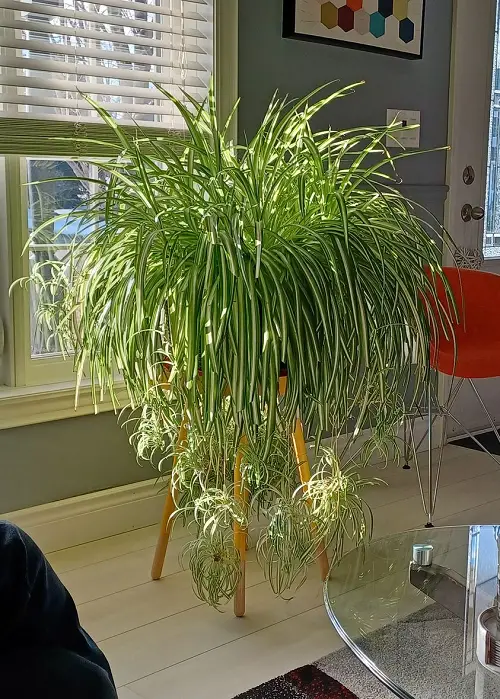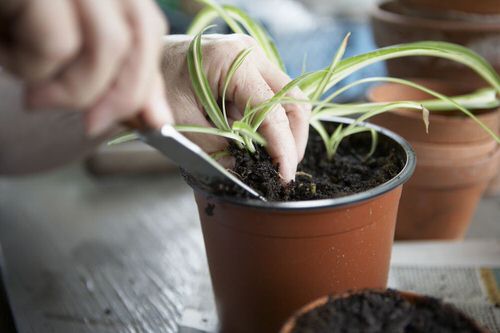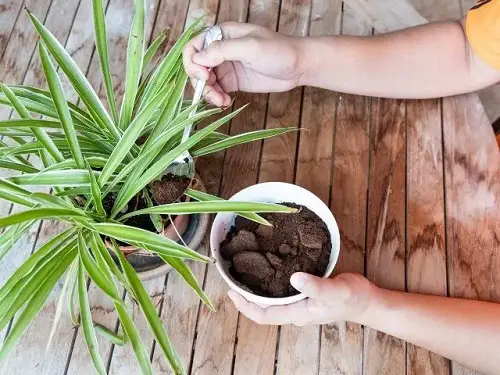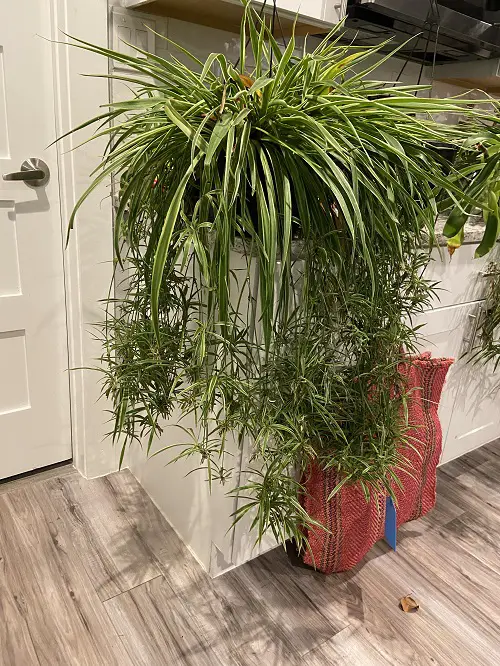Learn “how to make a spider plant bushier” for a luxuriant display of this low-maintenance houseplant with these solid tricks that work!

The iconic spider plant, botanically known as Chlorophytum comosum, is a beloved choice for indoor gardening due to its graceful arching leaves and air-purifying abilities. And if you’re looking to enhance its lushness and create a more luxuriant display, this guide on “how to make a spider plant bushier” is just for you.
How to Make a Spider Plant Bushier & Lush
1. Choose the Best Pot
Choosing the right pot for your spider plant can significantly impact its “bushiness.” You should always go for a slightly smaller pot than what you have in mind. It’s probably just one size bigger than the rootball.
A snugger fit encourages root growth and subsequently stimulates foliage expansion, resulting in a bushier appearance.
Plant Pot Sizes from Inches to Gallon
2. Proper Pruning Technique
Pruning may seem counterintuitive, but selectively removing older or discolored leaves encourages the plant to allocate more energy to new growth.
Trim the leaves close to the base, and as a response, the spider plant will redirect its resources to produce fresh shoots and leaves, making the plant denser over time.
3. Divide and Plant New Ones Together
Spider plants have a natural tendency to produce “spiderettes” or baby plants at the end of long shoots.
Gently remove these once they’ve developed a few leaves and their own root systems. Replant them in the same pot or separate containers to create a fuller, bushier arrangement.
Spider Plant Care Indoors | Growing Spider Plant in Home
4. Feed Spider Plants Regularly
Feed your spider plant with a weak-strength (1/4 to 1/2 of the recommended dose) balanced liquid fertilizer regularly during its active growth phase (spring and summer) every 2 to 4 weeks. Reduce fertilizing in fall and suspend in winter if you live in a cold climate.
Choose a formula with equal nitrogen, phosphorus, and potassium ratios to support overall plant health and encourage robust leaf growth, resulting in a bushier appearance.
How to Force Spider Plants to Flower to Have More Spider Plants
5. Control the Light Exposure

Spider plants thrive in moderate, indirect light. However, exposing them to a bit more light than usual for a short period can stimulate branching and bushiness.
Gradually introduce them to slightly brighter conditions, but avoid direct sunlight, as it can scorch the leaves.
6. Try Music Therapy
Believe it or not, some gardeners have experimented with sound therapy to encourage plant growth.
While the science behind it is still debated, some studies suggest that playing calming music or even softly speaking to your spider plant could stimulate growth and overall health.
If you are inclined to experiment, consider these genres:
Jazz and Symphony
Some research suggests that harmonic tunes like jazz and symphony have a positive effect on plant growth.
Blues
Given that blues often have a soothing rhythm, it could theoretically provide a calming environment, although there is no specific evidence to back this up for spider plants.
When to Use and How
- Duration: Playing music for about 2 to 3 hours per day is a common recommendation.
- Time of Day: The best time to play music would be during daylight hours, coinciding with the plant’s natural growth cycle.
Precautions
- Ensure that the volume is not too loud, as excessive vibrations could potentially harm the plant.
- Always observe your plant closely to check for any signs of stress or adverse reactions.
Key Takeaway: The vibrations from sound waves might influence nutrient uptake and cellular processes, potentially leading to a bushier appearance of your beloved spider plant.
7. Provide an Epsom Salt Boost
Dissolve a small amount of Epsom salt (magnesium sulfate) in water and use it to water your spider plant once a month during the growing season. Magnesium is essential for photosynthesis and overall plant health.
Some plant growers believe that providing this mineral boost can encourage more vigorous growth, potentially resulting in a bushier appearance.
Here are some amazing uses of Epsom Salt for houseplants
8. Practice Root Pruning
Remove your spider plant from its pot every couple of years, and gently prune its roots. Trim away excessively long or circling roots, which can contribute to root-bound conditions while limiting the new growth.
Replant the pruned spider plant in the same pot or a slightly larger one with fresh soil.
Key Takeaway: This root pruning can stimulate new root growth and encourage the plant to invest energy in expanding its foliage, resulting in a fuller appearance.
Conclusion
Transforming your spider plant into a bushy masterpiece can’t happen overnight journey. It requires a blend of care, technique, and patience. By following these spider plant care tricks, you’ll be able to transform your average spider plant into a verdant showstopper that brings vibrancy and elegance to your indoor space.
Is There a Pink Spider Plant | How To Grow a Pink Spider Plant
Frequently Asked Questions
Q1: How Often Should I Prune My Spider Plant?
A1: Prune your spider plant as needed, typically every few months. Remove any discolored or damaged leaves to maintain its appearance and health.
Q2: Can I Place My Spider Plant Outdoors to Make It Bushier?
A2: While a brief outdoor stint during mild weather can benefit your spider plant, avoid harsh sunlight and extreme temperatures. Gradually introduce it to outdoor conditions and bring it back indoors before the weather becomes unfavorable.
Q3: Is Misting Beneficial for Spider Plant Bushiness?
A3: Misting spider plants can increase humidity, which they appreciate. While it won’t directly make them bushier, maintaining proper humidity levels can support healthy growth and foliage development.
Types of Spider Plants | Different Varieties of Spider Plants
Q4: Why Are the Tips of My Spider Plant Turning Brown?
A4: Brown tips are often a sign of low humidity or inconsistent watering. Ensure the plant’s soil remains consistently moist but not waterlogged, and consider placing a humidity tray nearby.
Q5: How Long Does It Take To See Results After Implementing These Tricks?
A5: It may take at least a couple of months to notice a significant increase in bushiness. Patience is key, as plants respond to care and changes in their environment at their own pace.




Honestly, I have said for years that talking gently to plants, encourages them.
I have recommended this to others but I think they just believe I’m a crazy plant lady.
I tell them how beautiful they are.
I would respond to someone telling me I am beautiful, whether I believed them or not.❤️😃lol.
My mother always talked to her plants and they where all healthy and so beautiful. She could’ve won awards for them. So, yes I talk to my plants too!
Brown tips on spider plants may also be a symptom of the fluoride that’s added to many municipal water systems. I filter the water I use for drinking and cooking because fluoride is bad for my thyroid so I give filtered water to my spider plant as well, and guess what? No more brown tips on my spider plant.